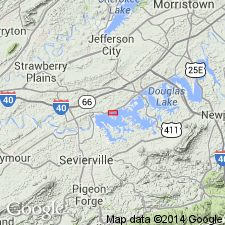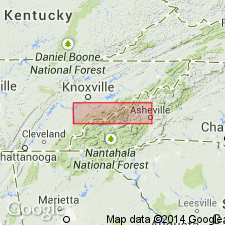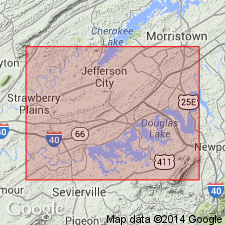
- Usage in publication:
-
- Douglas Lake member*
- Modifications:
-
- Original reference
- Dominant lithology:
-
- Conglomerate
- Chert
- Dolomite
- AAPG geologic province:
-
- Appalachian basin
Summary:
Pg. 727-729. Douglas Lake member of Lenoir limestone. Proposed for beds overlying Mascot dolomite and underlying typical nodular member of the Lenoir in Douglas Lake area, Jefferson County, eastern Tennessee. Member is composed of several rock types including rubble conglomerate, chert conglomerate, and black dolomite; the chert conglomerate overlies the rubble conglomerate (that occurs in depressions or sinks on upper surface of the Mascot) and at other places forms the lower part of the member; the black fine-grained thick-bedded dolomite, as much as 30 feet thick at the two large sinks, grades upward almost imperceptibly into typical Lenoir limestone; the Douglas Lake, therefore, is regarded as a discontinuous member of the formation. Age is Middle Ordovician.
Type locality: on north shore of Douglas Lake, 1.5 mi northeast of Douglas Dam, Jefferson Co., eastern TN.
Source: US geologic names lexicon (USGS Bull. 1200, p. 1150).

- Usage in publication:
-
- Douglas Lake member*
- Modifications:
-
- Areal extent
- AAPG geologic province:
-
- Appalachian basin
Summary:
Pg. 145 (table), 147. In the Tellico-Sevier belt, eastern Tennessee, the Douglas Lake is basal member of the Lenoir. Underlies Mosheim member. Age is Middle Ordovician.
Source: US geologic names lexicon (USGS Bull. 1200, p. 1150).

- Usage in publication:
-
- Douglas Lake Member*
- Modifications:
-
- Overview
- AAPG geologic province:
-
- Appalachian basin
Summary:
Douglas Lake Member is restricted to paleokarst depressions on the Knox surface and its thickness is controlled by the depth of the depressions. Unit is composed of a variety of lithologies including conglomerates, detrital quartz/chert sandstones, shaly dolostones and volcanic ash. At Douglas Dam, a paleokarst depression is filled with 37 m of volcanic ash, conglomerate and shaly dolomite. At Dandridge Municipal Park, the basal conglomerate is approximately 2.3 m thick and consists of unsorted, rounded to subangular, limestone and dolostone clasts and sand-sized quartz and chert grains in a matrix of finely crystalline dolomite. Conglomerate is overlain by 3 to 3.5 m of brown to red sandstone of sub-equal parts of quartz and chert grains. Trough cross-beds are present in the thicker, coarser-grained beds. Sedimentary features in the upper part of the Douglas Lake suggest tidal flat deposition. Member pinches out at the eastern end of this outcrop where the nodular limestones of the Lenoir directly overlie the Knox. Age is Middle Ordovician.
Source: GNU records (USGS DDS-6; Reston GNULEX).
For more information, please contact Nancy Stamm, Geologic Names Committee Secretary.
Asterisk (*) indicates published by U.S. Geological Survey authors.
"No current usage" (†) implies that a name has been abandoned or has fallen into disuse. Former usage and, if known, replacement name given in parentheses ( ).
Slash (/) indicates name conflicts with nomenclatural guidelines (CSN, 1933; ACSN, 1961, 1970; NACSN, 1983, 2005, 2021). May be explained within brackets ([ ]).

